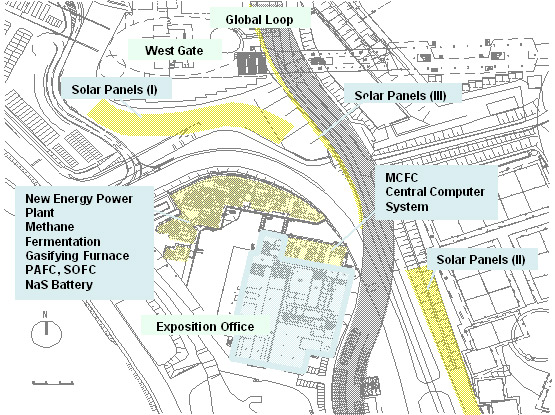2. New energy power generation plant in the exposition
System of the new energy electric power generation plant, demonstrated and exhibited in the exposition, is shown schematically in Fig. 2. Solar power, wind power and fuel cell power are so-called new energy in Japan. Electric power generated by the new energy is much smaller than conventional electric power generated with fossil fuel and atomic energy. But the new energy is expected to be firstly environmentally friendly and secondly appropriate for a compact power generation for small regional community.
Especially wind power and solar power are appreciated to be environmentally friendly without air pollution. But, the out put power is very unstable because they are much influenced by weather. This unstable power affects voltage stability of conventional electric power distribution lines, because they are connected to the lines, generally. To solve this, application of rechargeable battery is the best way. A Sodium Sulfur (NaS) battery, which has the highest energy density among rechargeable batteries, will be installed in the exposition. Wind power is not introduced because there is very little wind at the exposition area.
Fuel cells will be introduced to the exposition for a co-generation system, which makes electricity and heat. Fuel cells promise high energy efficiency. Heat exhausted from the fuel cells will be applied to air conditioning for adjacent pavilions. Thus, fuel cells are expected to be a co-generation system adequate for small regional community in near future. In the exposition, data of electricity collected from the fuel cells and the solar power will be examined from the view point of cost, quality and reduction of Carbon di-oxide gas.
When pavilions were constructed in the exposition area, some trees in the area had to be cut, unfortunately. These trees are ground to powder with a mill, and then, the powder will be fed into a gasifying furnace installed in the exposition area to obtain fuel gas for one fuel cell. When the exposition starts, big amount of food garbage comes from restaurants opening in the exposition area. This garbage will be fed to methane fermentation system in the exposition area to take out methane gas, and this gas will be also supplied to another fuel cell. Solid residuals after the methane fermentation are re-used for a compost of trees.

Fig. 3. Arrangement of the new energy plant.
Thus, we will carry out 3R (Reduce, Recycle and Re-use) for the exposition. Fig. 3 shows arrangement of the new energy plant around the Common 5 in the Nagakute exposition area. A photographic view of the plant is shown in Fig. 4. Visitors walking on the global loop can look at the plant, and visitors getting permission by the exposition office can watch details of the plant on the ground.

Fig. 4. Photographic view of the new energy plant.
The demonstration of the new energy plant in the exposition is carried out by a consortium associated with 9 organizations (Chubu Electric Power Co., Inc., Toyota Motor Corporation, NTT Facilities, Inc., NGK Insulators, Ltd., Mitsubishi Heavy Industries, Ltd., Kyocera Corporation, Japan Environment System, Aichi Prefecture, Japan Association for the 2005 World Exposition), based on a 5 years grant given by the New Energy and Industrial Technology Development Organization in Japan. After the exposition is finished, the plant will be moved to Tokoname-city, and the demonstration will be lasting for rest 4.5 years.


